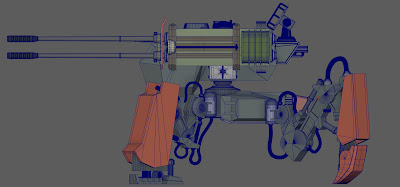Real Time Game Asset - Cannon
Introduction
For my real time cannon asset, I have chosen to make a mobile anti-aircraft artillery cannon... which happens to be in mech form. The model is from a tabletop game called Dust Tactics, which takes place in an alternative 1947 during World War 2, where the Allies and Axis powers use walking mechanized weaponry. The aesthetic focuses on big shapes and analog mechanical parts.
I will have a mixed method of capturing tertiary details with low poly geo, baked geo, and painted normals, as it is important to capture some fine details in order to break up the silhouette.
Final Renders
Research and Reference
I wanted to find a mech that had big and simple shapes, and could be box modeled without much guesswork. The mech I settled on is called "Dust Tactics: Heavy Panzer Walker Konigsluther, Sturmkonig." I searched Google and Pinterest for reference photos of as many unique angles as I could find. When that wasn't enough, I went to youtube and looked for video reviews of the model, and found 3 good quality results, from which I took screenshots of the exact angles I needed.
Reference Photos
Modeling Process
I plan to use a few different tools and methods to get a high poly for baking, as there are some new things in Zbrush that I aim to test with this project. Basically, I plan to heavily use Zbrush's new Live Boolean, in conjunction with deformation polish, clay polish, Zremesher, and projection. These tools should allow me to work out a base-mesh of intersecting and downright ugly topology, along side simple subdiv meshes, to achieve a final high poly. Many of these first meshes will be used as my low poly after a bit of cleanup. My workflow is as follows:
1) Box model almost everything, using subdivision modeling, high fidelity bevelling, and simple hard edge box shapes. Some meshes are intersecting, some are sewn together, others are modelled with subdiv - all depending on what was easiest.
1) Box model almost everything, using subdivision modeling, high fidelity bevelling, and simple hard edge box shapes. Some meshes are intersecting, some are sewn together, others are modelled with subdiv - all depending on what was easiest.
2) Meshes which are done correctly using subdiv modeling are duplicated off before the smooth and saved as a potential low poly mesh. All meshes are sent to Zbrush where they will be booleaned together, have their machined cuts (tertiary details) then booleaned out, Zremeshed, projected back into, divided up, polished using the deformation menu, decimated, and finally exported.
3) The low poly will consist of earlier meshes cleaned up and welded to vertex efficiency, as well as new retopoed mesh. I will be baking in Marmoset Toolbag 3, and using the Skew Painter. This tool allows me to have the absolute minimum number of edge loops required, as I can avoid normal skewing in the bake.
4) Color ID, AO, and Normals will be baked in Marmoset Toolbag 3
5) Texturing will be done in Quixel Suite 2, as well as Substance Painter. Quixel for its high fedelity PBR scanned materials, and Substance Painter for its painting tools and projection mapping.
6) Final renders will be made in Marmoset Toolbag 3
6) Final renders will be made in Marmoset Toolbag 3







































No comments:
Post a Comment